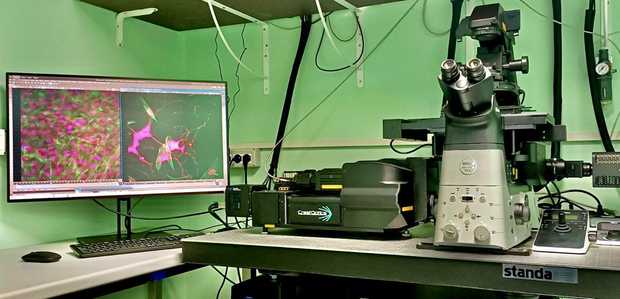The Platform
The platform is equipped with up-right and inverted fluorescent microscopes, and analysis workstations.
Imaging applications include:
- Real-time visualization of dynamic cellular processes (signaling, intracellular transport, organization of organelles and subcellular structures)
- Single-cell analysis, to visualise cell heterogenity within a population
- Recording of cellular morphological changes or cell death (in response to particular stimuli, damage, stress conditions)
- Measurements of cell migration
- High definition analysis of subcellular structures (5 fluorescence excitation channels, simultaneous visualization of 4 stainings, deconvolution)
- Proximity ligation assays for in situ protein interactions and in situ post-translational modifications.
Equipment
Nikon Eclipse 90i upright microscope

The Nikon Eclipse 90i is an up-right microscope for the analysis of fixed samples (fluorescence and bright-field)
- Digital head, to perform all microscope-associated operations (shutter, filter change, objective change) both in manual and digital mode
- motorized along the z-axis, to acquire stacks of images on different focal planes
- acquisition software Nis-Elements AR
- Intensilight fluorescence lamp
- Objectives: Plan Fluor Nikon 20x (N.A. 0.5), 40x (N.A. 0.75), 100x (oil, N.A. 1.3)
- Filter cubes: DAPI (Ex 360/40; BS 400LP; EM 460/50), GFP (Ex 470/40; BS 495LP; EM 525/50), Cy3 (Ex 545/30; BS 570LP; EM 610/75), Texas Red/Cy3.5 (Ex 560/40; BS 595LP; EM 630/60), Cy5 (Ex 620/60; BS 660LP; EM 700/75)
- Digital camera QiCAM Fast 1394 (QImaging): monochrome cooled camera; 1392 x 1040 pixels; 4.65µm x 4.65µm pixel size
Nikon Eclipse Ti inverted microscope

The Nikon Eclipse Ti is an inverted motorized microscope indicated for time-lapse recording of live samples, using DIC (differential interference contrast), Phase Contrast and fluorescence
- completely motorised to perform all functions in automated mode (z-axis, xy stage movement, microscope camera and lamp functions)
- integrated Perfect Focus System (PFS): corrects focus drifts during long-term observations.
- Acquisition software Nis-Elements AR with JOBS module: allows personalized experimental settings, e.g., acquisition intervals, choice of observation fields (multipoint acquisition), fluorescent channels, time exposure, z-axis. Automated and conditioned acquisition workflows can be easily executed
- Okolab stage incubator, allowing prolonged observations (up to 5-6 days)
- Intensilight fluorescence lamp, with six discrete levels of light intensity
- Set of objectives for DIC, Ph, fluorescence
- Filter cubes: DAPI (BFP-A, Semrock), FITC (EX 480/30, BS 505, EM 535/40), TRITC (EX 535/50, BS 575, EM 590LP)
- Digital camera Clara (Andor): cooled monochrome, 1392 x 1040 pixels; 6,45 µm x 6,45 µm pixel size
Nikon Eclipse Ti2-E spinning disk inverted microscope

Nikon / CrestOptics spinning disk confocal system, designed to deliver high-throughput, simultaneous imaging of high numbers of samples
Last generation Nikon T2 microscope and spinning disk
- Inverted microsope with currently available widest field of view (25 mm): maximizes the area of the camera sensor, significantly increasing the data flow and reducing the time for data acquisition and analysis by 30%;
- Last generation Perfect Focus System: enables the focal plane of live cells to be maintained for long observation times (e.g. over several days)
- Confocal spinning disk system (CrestOptics V3) with high-efficiency quantum chamber
- Okolab stage incubator, allowing prolonged observations (up to 5-6 days)
- Light: LED sources, with low impact on cell viability for live imaging applications and 7 fluorescence channels, or alternatively laser channels
Image acquisition and processing
- Automated or manual mode for image acquisition in various dimensions (high content)
- Nis Advanced Research module for confocal image processing, supporting very high spatial resolution; the Nis-elements AR software with Jobs module enables the handling and analysis of large data in real time
- Automated classification and analysis of imaging data, can support imaging studies at the "omics" level (phenotype profiling, screening projects…)
- Increased computational level to process high-throughput, high content data based on machine-learning
Workstations for data analysis

Nis-Elements HC software with:
- deconvolution
- creation of image projections from z-stacks using Maximum Intensity Projection, Minimum Intensity Projection, Extended Depth of Focus functions
- 3D visualisation of z-stacks
- manual or automatic (binarization) measures and counting of: geometric features (distances, lengths, areas, etc.), volume measurements, signal intensity (mean, sum, profile), number of objects, colocalization module, measures over time.
- bio-analyses: wound healing assays, proliferation assays, cell tracking, cell count
- elaboration of quantitative data: automatically generated tables and histograms of several measured values, with statistics, easily exported to excel worksheets;
- qualitative elaboration of analysis using LUTs
- easy annotation on images (e.g., associated measured data, labels, scalebars)